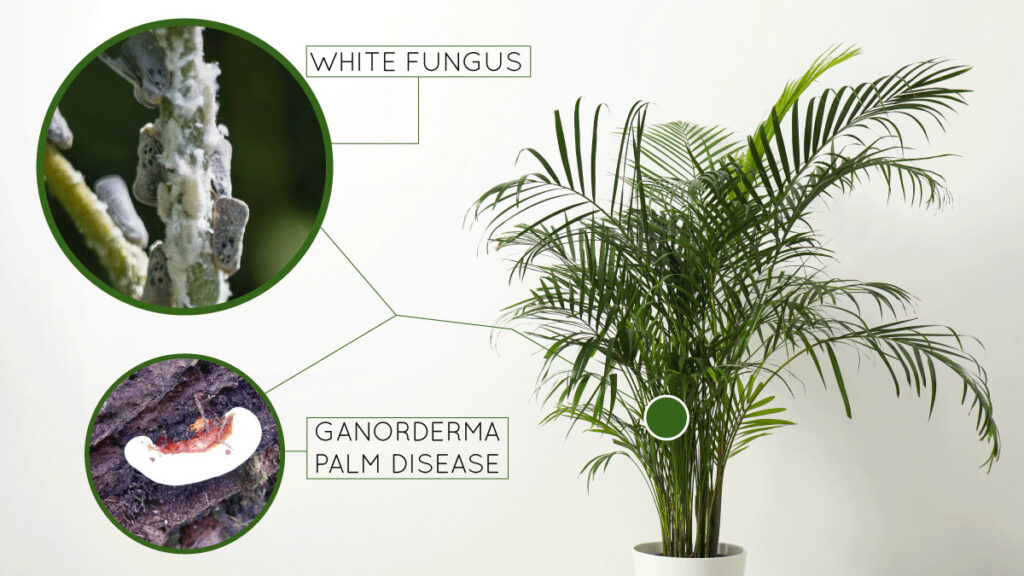White fungus, resembling white fluff, often appears under tree fronds, and it is a common problem for palms and palm-like trees. This disease spreads throughout the leaves and blocks the sunlight, preventing growth. If the fungus is not treated and the affected fronds are not removed, it will lead to devastating results and could even kill the palm tree.
If a palm tree is infected with white fungus, remove the diseased area as soon as you see any signs. It resembles white cotton, and insects spread it. Removing infected leaves or treating them with fungicides are the best remedies to kill or prevent the fungus from spreading.
White fungus will kill your palm tree if you do not act quickly. The whitish powdery granules typically start on the bottom of the leaves and gradually move to the upper side. The fungus must be stopped before it spreads to the stems and roots, and here is how you do it.
How to Get Rid of White Fungus on Palm Tree

It helps to know where this fungus comes from to help you combat the problem. The white fungus on palms mainly comes from two insects. The first is called the “Spiraling Whitefly.” This bug feeds on the leaves’ sap until it loses its ability to photosynthesize and turn yellow. The second is called the “Cycad Scale.” This insect does not feed on true palm trees but infects and kills untreated palms.
It normally starts at the bottom of the leaf, but it will eventually spread to the top and later to the palm stem and roots. The Spiraling Whitefly excretes a sugary liquid called honeydew on the leaf, which attracts fungi called Sooty mold. Unlike Cycad Scale, Sooty mold fungi do not kill the tree, but it does cause it great distress.
Here are steps to rid your palm tree of white fungus.
Remove Infected Parts as Soon as Possible
It is vital to prevent the fungus from spreading, and the fastest and most natural way is to remove the infected leaves. Sooty mold attracted by Spiraling Whitefly honeydew is a progressive fungus that first attacks the underside of the leaf before spreading. Removing the infected leaves may seem aggressive, but the palm will produce new leaves.
Eliminate Overhead Irrigation
White fungus prefers moist areas, and keeping the palm leaves dry can slow its growth. Palm trees do not need water on their leaves to grow; they feed through a root system underneath the ground. If you irrigate your palms with a sprinkler system, consider only watering their roots with a hose, which will provide water for growth, keep the leaves dry, and prevent developing mold.
Increase the Distance Between Palm Trees
Proper exposure to sunlight is a good way to keep palm leaves dry, which prevents mold from growing. Overcrowded trees promote moist conditions for mold growth and the fungus to spread easily between trees.
Spray Fungicidal Remedies on Affected Palm Trees
Using chemicals to kill white fungus is more invasive and expensive, but sometimes, it is the only way to save the palm. If the disease is in its early stages and only visible in a small area and under the leaves, you should start by removing the infected leaves.
If the fungus has spread to the upper parts of the leaves or onto the stem, you must consider using a fungicidal spray. There are organic and inorganic fungicides that you can consider:
- Organic fungicides are typically homemade spray-on methods, including baking soda, neem oil, or a milk solution, but apple cider vinegar and ginger oil also work.
- Inorganic fungicides are manufactured solutions sold in stores with specific application instructions to avoid damage to the palm tree.
How to Treat Palm Tree Fungus
A plant disease is often the reason why palms deteriorate or die, and there are various types, including white fungus, Ganoderma Butt Rot, Fusarium Wilt, and Leaf Blights. The first signs that your palm has a fungus are white fluff and yellowing leaves. Previously, I discussed white fungus, so let’s look at the other three and how it affects your tree.
Ganoderma Butt Rot
The Ganoderma Zonatum fungus causes Ganoderma Butt Rot in palm trees, starting at the trunk’s bottom 4 to 5 feet. The trunk rots from the center, which makes it hard to notice because the outer trunk is solid and hard. Possible signs of Ganoderma Butt Rot include growths, dark brown spots on its trunk, and when it makes a hollow sound when you tap it.
There is no remedy for Ganoderma Butt Rot, and if your tree shows signs, it is best to remove it before it infects your other palm trees. It is also wise not to plant a palm where you removed the infected tree to avoid it returning and spreading.
Fusarium Wilt on Palm Trees
Pruning equipment is the leading cause of Fusarium Wilt spreading to palms. The Fusarium Wilt fungus affects the water through the tree, starts showing on the lower leaves, and gradually works to the top part of the leaves. The palm leaves turn yellow until the growing tip dies.
Unfortunately, there is no remedy for the Fusarium Wilt fungus, and it is best to remove the tree entirely to prevent the disease from spreading to other palms. The only way to prevent your palm from being infected is by regularly sanitizing your pruning equipment. You must not plant another palm in the spot where you removed the infected palm because the fungus lives in the soil.
Leaf Spots and Leaf Blights
Leaf Blights and Leaf Spots are similar fungal diseases and show similar symptoms. Infected palm trees develop small water spots that increase and spread as the disease grows. The water spots turn yellow, gradually changing to brown, gray, or black with a different color outer ring. Pruning equipment, wind, and water are the leading cause of the fungus spreading to other palm trees.
Some fungicides prevent palm trees from being affected but with little success. The best remedy is to remove and burn leaves that show signs to avoid contaminating other trees. Preventative measures include sanitizing your pruning equipment and avoiding overhead watering, contributing to Leaf Spots and Leaf Blights.
Final Thoughts
Various fungi affect or kill palm trees; white fungus is the most common. Coton-like fluff below the palm leaves indicates that your palm has contracted the disease.
Removing the affected leaves or spraying organic and inorganic fungicides are the best ways to rid your palm tree of white fungus.

